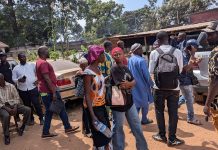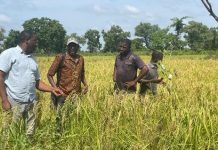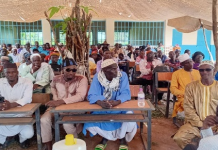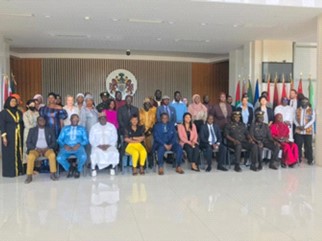By Nelson Manneh
The International Organization for Migration (IOM) has on Tuesday, 22 June 2022 launched the multi-partners trust fund join project.
The joint programme, funded by the Migration Multi-Partner Fund, seeks to address the challenges of security, safety, and prosperity in a novel approach through interlinked interventions.
The Senegambia Bridge, since its inauguration in 2019, has contributed to a significant increase in migration and mobility. For the first time, the northern and the southern halves of The Gambia are connected by road, as the bridge links Farafenni in the Upper Baddibu District to Mansakonko, Soma and Jarra Jenoi in the Jarra West District.
While creating economic opportunities, the reduced transit times and the increased number of transiting people also led to amplified vulnerabilities, especially for women and youth in the border communities along the route.
The programme which focused on the Trans-Gambia transport corridors, will empower women and youth from these communities to navigate borders safely, enhance knowledge and safeguard their rights.
Mr. Seyaka Sonko, the Minister of Interior, said migration has existed since the beginning of mankind, and that it is one of the defining phenomena of the 21st century. He added that it poses a huge opportunity for growth and development, but also poses challenges they must address, such as irregular migration, forced displacements, abuse, and labour exploitation, among others.
“The Senegambia Bridge continues to register significant achievements by connecting people, facilitating trade, and promoting integration and free movements of persons, goods, and services. We have also witnessed significant challenges due to increase in migration and labour mobility,” he pointed out.
Minister Sonko said The Gambia is a Country of transit and destination for an increasing number of migrants, stressing that there is a need for improved capacity to manage borders to meet their critical and growing needs, particularly in the face of limited capacity for national security surveillance.
He disclosed that considering the combination of activities taking place along the Trans Gambia transport corridor, it is clear that there is a dire need to strengthen the human and operational capacity of the borders, in order to help curb organised criminal activities and address the challenges of increased number of transiting people, especially for women and youth in the border communities along the route.
“This project has been developed through a series of consultations and discussions both at local and central levels. These engagements were based on the vulnerabilities arising from the communities bordering the southern and northern regions along the Trans-Gambia route.
“This was understood by all stakeholders including the beneficiary communities,” he said.
The Interior Minister said the project aims at ensuring that border authorities at key border posts of the Trans-Gambia transport corridor effectively facilitate safe and orderly migration for youth and women.
Mrs. Yassin Gai, a representative from the International Trade Centre (ITC), said the project was conceptualised in 2021 after many discussions between the Ministries, agencies, and relevant stakeholders. The main objective was to come up with an initiative that addresses the drivers and causes of migration-related vulnerabilities among border communities along the Trans-Gambia transport corridor.
In December 2021, she said the Board of the Migration Multi-Partner Trust Fund of the United Nations, formally approved the proposed programme.
Yassin reiterated: “This means that for the first time, The Gambia was able to access funds from the Trust Fund.”
She said that over the last 6 months, they embarked on a number of assessments, consultations and developed the work plan that the Project Steering Committee will review in its inaugural meeting
Madam Gai added that the new initiative focuses on the Trans-Gambia transport corridor, an economic and strategic link connecting the northern and southern parts of both The Gambia and Senegal, and by extension to other ECOWAS countries.
“The recently inaugurated Senegambia Bridge has enhanced and facilitated movements by reducing transit times within the ECOWAS Zone along the Trans-Gambia transport corridor, thereby boosting trade opportunities. In a way, the bridge symbolises the role of enhanced trade and connectivity in building prosperity,” she disclosed.
Given the country’s vast, porous, and sparsely monitored borders, she said the border communities in Jarra West (LRR) and Upper Baddibu (NBR) are particularly affected.
Gai further lamented that high rates of irregular migration of young people, human trafficking, smuggling of migrants and other forms of organised immigration crime, and harassment of women at border posts, particularly female small-scale cross-border traders, are few priority issues that the programme seeks to address.
Mr Hassan Gaye, the Permanent Secretary, Ministry of Trade, said the 36-month Migration- Multi-Partner Trust Fund joint programme seeks to address the drivers and causes of migration-related vulnerability among border communities in the Gambia.
According to him, in every development, there are winners and losers, pointing out that the development of the bridge has created exactly that. He stressed that the Senegambia Bridge has expedited movements, connected regions, and even strengthened international cooperation. However, PS Gaye noted that it has hugely impacted the lives and livelihood of ordinary people, cross-border traders, women and youth along the transport corridor.
“The reduction in transit times has increased the vulnerabilities of the people, especially the women that owned businesses and petty traders at the then Bamba Tenda-Yelitenda crossing point,” he revealed.





















